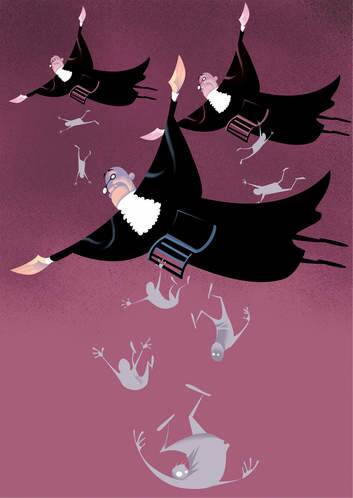The latest collection of prison statistics released by the Australian Bureau of Statistics on November 22 could provide the basis for any number of stories about the ACT. Of particular interest, however, is what these data can tell us about the real effectiveness of the so-called ''blitz'' on our court system a few months ago.
Subscribe now for unlimited access.
$0/
(min cost $0)
or signup to continue reading
On August 4 this newspaper gave front page coverage to a fairly long report with the headline ''Court blitz judged a winner'' which contained details of the numbers of criminal and civil cases which had been resolved or cleared as the result of more effort being made to achieve maximum effectiveness of the actual time that Supreme Court judges were hearing cases, and by encouraging barristers to resolve civil cases more quickly, even without going to hearing.

The Attorney-General, Simon Corbell, said that the blitz had been a success and had encouraged a ''cultural shift'' in the way justice was done in the territory. Spokespersons for the ACT Bar Association, Philip Walker, and the ACT Law Society, Noor Blumer, while not being critical of the blitz, warned that the battle was not over and expressed concern over the increased numbers of reserved judgments which would take considerable judicial time to finalise.
However, neither of the two central figures responsible for the courts, the Chief Justice and the Chief Magistrate, were cited as having any view on the effectiveness of the blitz.
The blitz itself was conducted over two six-week periods starting in April and cost the ACT government $1.2 million. That money was spent on two temporary appointments of Supreme Court judges, additional support for the Director of Public Prosecutions, legal aid services and administrative staff in the courts themselves.
The blitz undoubtedly reduced the backlog of civil and criminal cases listed for hearings in the Supreme Court but in my view failed completely to have any impact on the unacceptably high numbers of accused persons awaiting trial or sentence as remandees in the Alexander Maconochie Centre.
On November 25, Ms Blumer, in her capacity as the president of the ACT Law Society, expressed concern about the growing backlog of cases before the Supreme Court with hearings set for April and May 2014. She said: ''It is particularly hard on accused [persons] who have not been granted bail and must remain in remand for lengthy periods without trial.'' That comment is directly relevant to the latest published prison statistics.
These statistics take the data up to the end of September this year and confirm that the ACT continues to have a higher proportion of its prisoners classified as unsentenced, or remandees, than any other Australian jurisdiction. And the difference between the ACT and the rest is not trivial; it is highly significant. On the last day of September 34.8 per cent (95 out of 273) of ACT prisoners were remandees, either waiting trial or sentence, while the national average was 23.7 per cent (6961 out of 29419).
We should be ashamed that our remand numbers are the worst in Australia. These number make a mockery of the claim that we in the ACT respect the human rights of all offenders in custody, either under sentence or on remand. Whatever happened to that belief that Canberra could be the model for the rest of Australia?
It is obvious that urgent and decisive action must be taken to resolve this problem.
On a previous occasion (in January of this year) I suggested that an additional judge should be permanently appointed to the ACT Supreme Court. I now believe that two new permanent judges will be needed to provide some breathing space for the current judges to catch up with the writing of reserved judgments as well as to provide the capacity to at last reduce the waiting time for remandees.
Perhaps surprisingly this option will pay for itself in a relatively short time. To bring the latest ACT figures into line with the rest of Australia the number of remandees would need to be cut from 95 to 55. (55 out of a total of 233 would be 23.6 per cent.) That would mean a reduction of 40 remandees. The Productivity Commission has estimated that average cost for keeping a prisoner in custody is $100,000 per year, and that figure would be considerably higher for the AMC.
That would mean a saving of at least $4 million per year, and that should be sufficient to meet the costs of two new judges and their support staff. If that goal could be achieved quickly it would also mean that the need for providing additional accommodation at the AMC could be deferred for perhaps one or two years.
The need for action on this problem is becoming increasingly urgent as we are hearing and reading about more magistrates who are continuing to release accused persons on bail, even if they have failed to meet the bail conditions on one or more previous occasions, because they do not want the suspected offenders to spend many months or years in custody on remand.
It is also relevant to note that a considerable number of research studies have found that a considerable proportion of the people remanded in custody are acquitted at the trial stage or are simply sentenced to the period of time that they have spent in custody. For those who are found not guilty no compensation is offered for their lost time in custody.
Finally, it must said that the national proportion of just under 24 per cent is nothing to make us really proud. I can recall, albeit some 30 or 40 years ago, when the figure was around 10 per cent. Perhaps that should be the real target.
David Biles is a Canberra-based consultant criminologist.

